Linear Equations in Linear Algebra
1.2 Row Reduction and Echelon Forms
A nonzero row or column in a matrix means a row or column that contains at least one nonzero entry.
A leading entry of a row refers to the leftmost nonzero entry in a nonzero row.
Definition of Echelon Form
A rectangular matrix is in echelon form (or row echelon form, REF) if it has the following three properties:
- All nonzero rows are above any rows of all zeros.
- Each leading entry of a row is in a column to the right of the leading entry of the row above it.
- All entries in a column below a leading entry are zeros.
If a matrix in echelon form satisfies the following additional conditions, then it is in reduced echelon form (or reduced row echelon form, RREF):
- The leading entry in each nonzero row is 1.
- Each leading 1 is the only nonzero entry in its column.
- Echelon form : 사다리꼴
- Row Echelon form : 행사다리꼴
- Reduced row echelon form : 기약행사다리꼴. echelon = steplike
An echelon matrix (respectively, reduced echelon matrix) is one that is in echelon form (respectively, reduced echelon form.)
Example 1
The following matrices are in echelon form. The leading entries () may have any nonzero value; the starred entries(*) may have any value (including zero).
Any nonzero matrix may be row reduced (i.e., transformed by elementary row operations) into more than one matrix in echelon form, using different sequences of row operations. However, the reduced echelon form one obtains from a matrix is unique.
Theorem 1: Uniqueness of the Reduced Echelon Form
Each matrix is row equivalent to one and only one reduced echelon matrix.
If a matrix is row equivalent to an echelon matrix , we call an echelon form (or row echelon form) of ; if is in reduced echelon form, we call the reduced echelon form of .
Pivot Position
Since the reduced echelonform is unique, the leading entries are always in the same positions in any echelon form obtained from a given matrix.
These leading entries correspond to leading 1's in the reduced echelon form.
Definition of Pivot Position and Pivot Column
- A
pivot positionin a matrix is a location in that corresponds to a leading 1 in the reduced echelon form of . - A
pivot columnis a column of that contains a pivot position.
Example 2
Row reduce the matrix below to echelon form, and locate the pivot columns of .
Solution of Example 2
The top of the leftmost nonzero column is the first pivot position.
A nonzero entry, or pivot, must be placed in this position.
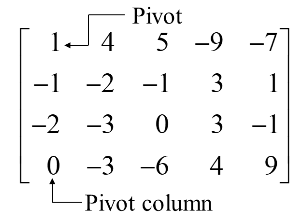
Create zeros below the pivot, 1, by adding multiples of the first row to the rows below, and obtain the next matrix.
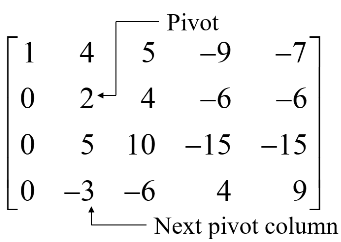
Add times row 2 to row 3, and add times row 2 to row 4.
There is no way to create a leading entry in column 3. However, if we interchange rows 3 and 4, we can produce a leading entry in column 4.
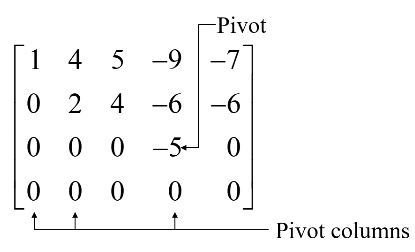
The matrix is in echelon form and
thus reveals that columns 1, 2, and 4 of are pivot columns.
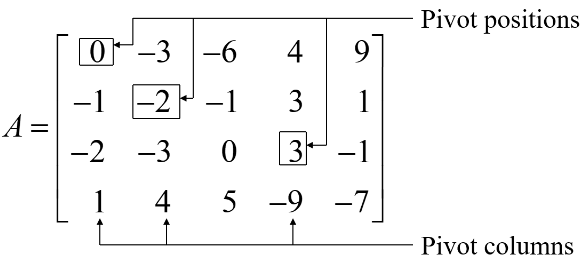
The pivots in the example are 1, 2 and -5.
Row Reduction Algorithm
The algorithm that follows consists of four steps, and it produces a matrix in echelon form.
A fifth step produces a matrix in reduced echelon form.
Example 3:
Apply elementary row operations to transform the following matrix first into echelon form and then into reduced echelon form:
Solution of Example 3
Step 1
Begin with the leftmost nonzero column. This is a pivot column. The pivot position is at the top.

Step 2
Select a nonzero entry in the pivot column as a pivot. If necessary, interchange rows to move this entry into the pivot position.
Interchange rows 1 and 3. (We could have interchanged rows 1 and 2 instead)
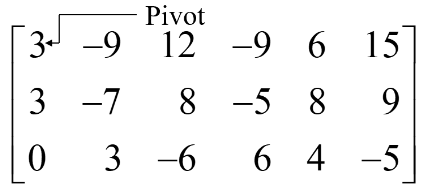
Step 3:
Use row replacement operations to create zeros in all positions below the pivot.
We could have divided the top row by the pivot, 3, but with two 3s in column 1, it is just as easy to add -1 times row 1 to row 2.

Step 4:
Cover (or ignore) the row containing the pivot position and cover all rows, if any, above it. Apply steps 1~3 to the submatrix that remains. Repeat the process until there are no more nonzero rows to modify.
With row 1 covered, step 1 shows that column 2 is the next pivot column; for step 2, select as a pivot the "top" entry in that column.
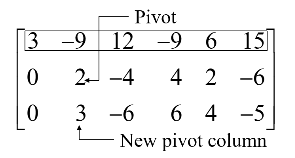
For step 3, we could insert an optional step of dividing the "top" row of the submatrix by the pivot, 2. Instead, we add times the "top" row to the row below.
This produces the following matrix.
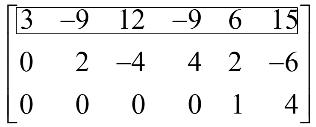
When we cover the row containing the second pivot position for step 4, we are left with a new submatrix that has only one row.
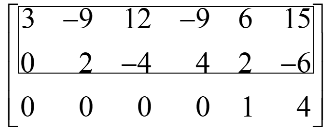
Steps 1~3 require no work for this submatrix, and we have reached an echelon form of the full matrix. We perform one more step to obtain the reduced echelon form.
Step 5:
Beginning with the rightmost pivot and working upward and to the left, create zeros above each pivot. If a pivot is not 1, make it 1 by a scaling operation.
The rightmost pivot is in row 3. Create zeros above it, adding suitable multiples of row 3 to rows 2 and 1.

The next pivot is in row 2. Scale this row, dividing by the pivot.

Create a zero in column 2 by adding 9 times row 2 to row 1.

Finally, scale row 1, dividing by the pivot, 3.

This is the reduced echelon form of the original matrix.
The combination of steps 1~4 is called the forward phase of the row reduction algorithm. Step 5, which produces the unique reduced echelon form, is called the backward phase.
Solutions of Linear Systems
The row reduction algorithm leads to an explicit description of the solution set of a linear system when the algorithm is applied to the augmented matrix of the system.
Suppose, for example, that the augmented matrix of a linear system has been changed into the equivalent reduced echelon form.
There are three variables because the augmented matrix has four columns. The associated system of equations is
The variables and corresponding to pivot columns in the matrix
are called basic variables. The other variable, is called a free variable.
Whenever a system is consistent, as in (4), the solution set can be described explicitly by solving the reduced system of equations for the basic variables in terms of the free variables. This operation is possible because the reduced echelon form places each basic variable in one and only one equation (각각의 방정식, 즉 각 행에 하나의 기본변수를 가지는 형태!). In (4), solve the first equations for and the second for (Ignore the third equation; it offers no restriction on the variables.)
The statement means that you are free to choose any value for . Once that is done, the formulas in (5) determine the values for and . For instance, when , the solution is (1,4,0); when , the solution is (6,3,1). Each different choice of determines a (different) solution of the system, and every solution of the system is determined by a choice of .
Parametric Descriptions of Solution Sets
The description in (5) is parametric description of solutions sets in which the free variables act as parameters(매개변수). Solving a system amounts to
- finding a parametric description of the solution set or
- determining that the solution set is empty.
consistent linear system
Whenever a system is consistent and has free variables, the solution set has many parametric descriptions. For instance, in system (4), we may add 5 times equation 2 to equation 1 and obtain the following equivalent system
We could treat as a parameter and solve for and in terms of , and we would have an accurate description of the solution set.
Existence and Uniqueness Qeustions
When a system is in echelon form and contains no equation of the form , with nonzero, every nonzero equation contains a basic variable with a nonzero coefficient. Either the basic variables are
- completely determined (with no free variables) or
- at least one of the basic variables may be expressed in terms of one or more free variables.
In the former case, there is a unique solution; in the latter case, there are infinitely many solutions (one for each choice of values for the free variables). These remarks justify the following theorem.
Theorem 2 : Existence and Uniqueness Theorem
A linear system is consistent if and only if the rightmost column of the augmented matrix is not a pivot column (가 0이 아니면서 형태의 equation이 없음) -- i.e.,if and only if an echelon form of the augmented matrix has no row of the form
If a linear system is consistent, then the solution set contains either
- (i) a unique solution, when there are no free variables, or
- (ii) infinitely many solutions, when there is at least one free variable.
Using Row Reduction to Solve a Linear System
- Write the augmented matrix of the system.
- Use the row reduction algorithm to obtain an equivalent augmented matrix in echelon form. Decide whether the system is consistent. If there is no solution, stop; otherwise, go to the next step.
- Continue row reduction to obtain the reduced echelon form.
- Write the system of equations corresponding to the matrix obtained in step 3.
- Rewrite each nonzero equation from step 4 so that its one basic variable is expressed in terms of any free variables appearing in the equation.